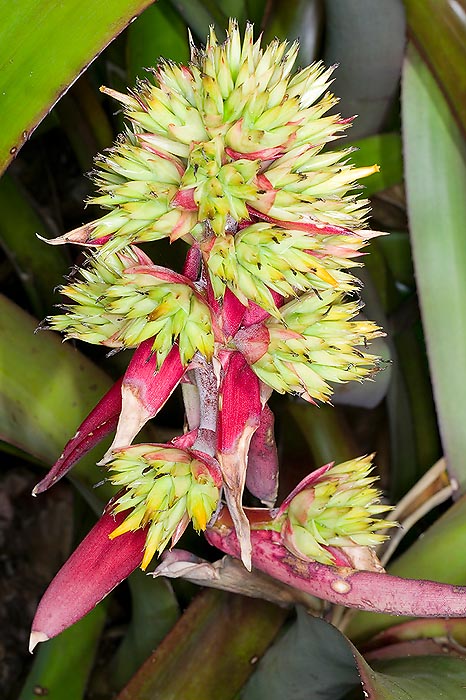Family : Bromeliaceae

Text © Pietro Puccio

English translation by Mario Beltramini

Monocarpic evergreen, it reproduces by seed and by new plants division © Mazza
The name of the genus comes from the Greek “aichme” = spearhead, with reference to the thorny apices of the sepals and of the floral bracts; the name of the species comes from the Latin “aquilega” = which collects water (from “aqua” = water, and “lego” = to collect), with probable reference to the abundant mucous secretion in the inflorescence.
Common names: “aqua bromeliad” (English); “bosananas”, “caraguata guacu” (Spanish).
Evergreen herbaceous plant, monocarpic (bearing fruit only one time during its existence), acaulescent, epiphytic or terrestrial, it has a funnel-shaped inflorescence of several leaves placed in way to form a central cavity, usually full of water.
The leaves are linear, thin, up to 1,5 m long, green, thickly covered by small white scales and with margins equipped with 1-5 mm, brown, thorns: when in full sun, the leaves assume a tone from pink to purple.
The inflorescence, at the centre of the rosette, is formed by 40-80 cm long floral scape, covered, in the lower part, by a thick white tomentum, provided with elliptic, pointed bracts, longer than the internodes, which overlap; the upper ones are of a red colour.
The scape end with a long lasting inflorescence, tall about 40 cm, formed by a compound raceme, that is, formed by more racemes departing from a central axis, the racemes, in a number of 10-20, are formed by clusters of compact flowers, normally enclosed in a mucous secretion.
The red bracts under the single racemes, are longer than the clusters of flowers, about 10 cm the lower ones, whilst those of the single flowers are oval, pointed, with a thorn at the apex; about 30 mm long and 15 mm broad, of a green colour. The flowers have orange-yellow, 15 mm long sepals, with a thorn at the apex, whilst the petals are 25 mm long and 3 mm broad, pointed, of orange-yellow colour.
It reproduces, besides by seed, by vegetative way through the new plants which come out at the base of the plant and which can be detached when they have reached the size of a third of the mother plant. Plant suitable for being cultivated in tropical and subtropical, with marked seasonal changes, climates, both in full sun and in slight shade and on soils even poor, sandy, particularly draining, being subject to rottenness due to water stagnation, especially in connection with low temperatures. In more humid climates, it can be cultivated also as epiphytic on the trees. Its best positioning, on the ornamental point of view, is in “desert” gardens, as it can stand an intense solar irradiation and poor availability of water.
It can be cultivated in pot for specious indoors decoration, for its dimensions and the presence of thorns, both in full light and in slight shade, utilizing a particularly draining and porous substratum, with temperatures over the 14-16°C. In summer, the substratum must be kept slightly humid and the ambient humidity, in presence of dry air and high temperatures, can be, in case, increased with nebulisations, utilizing water at room temperature and not calcareous for avoiding anti-aestethic dots on the leaves; in winter, watering are to be spaced in order to allow the substratum to get dry. In summer, some water can be left in the central cavity formed by the rosette of leaves, renewing same frequently to avoid that it becomes a nest of mosquito larvae, whilst in winter it is better to leave it dry for avoiding possible rottenness.
Synonyms: Bromelia aquilega Salisb. (1806); Gravisia aquilega (Salisb.) Mez (1892).
→ For general notions about BROMELIACEAE please click here.
